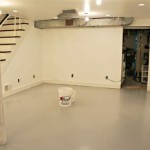How to Insulate Cement Basement Walls
Insulating cement basement walls is an important step in creating a comfortable and energy-efficient living space. Proper insulation can help to regulate temperature, reduce moisture, and prevent mold growth. Here's a step-by-step guide on how to insulate cement basement walls:
1. Preparation
Before starting the insulation process, it's crucial to prepare the basement walls. Remove any debris or dirt, and ensure the walls are clean and dry. Check for any cracks or holes and seal them using a suitable sealant. Make sure the walls are level and free of any uneven surfaces that could hinder the insulation's effectiveness.
2. Choose the Right Insulation
There are several types of insulation available for cement basement walls, including rigid foam, spray foam, and fiberglass batts. Rigid foam insulation is a popular choice due to its high R-value, ease of installation, and moisture resistance. Spray foam insulation expands to fill any gaps and provides excellent air sealing. Fiberglass batts are a more budget-friendly option but require additional framing to hold them in place.
3. Install Insulation
The method of installation will vary depending on the type of insulation chosen. For rigid foam insulation, cut the panels to the appropriate size and attach them to the walls using adhesive or fasteners. Seal the joints between the panels with tape or caulk to prevent air leakage. Spray foam insulation is applied using a specialized spray gun, which expands and adheres to the walls. Fiberglass batts require a framing system to be installed first. Secure the batts between the framing members, ensuring there are no gaps.
4. Cover Insulation
Once the insulation is installed, it's important to cover it with a vapor barrier. A vapor barrier prevents moisture from entering the insulation and helps to maintain its effectiveness. Use a plastic sheeting or a vapor-resistant paint to create the vapor barrier.
5. Add Moisture Control
In addition to a vapor barrier, it's recommended to install a moisture control system in the basement. This can include installing a sump pump to remove excess water, as well as a dehumidifier to control moisture levels in the air. Proper moisture control will prevent condensation from forming on the walls and insulation, which can damage the insulation and lead to mold growth.
6. Finish the Walls
After the insulation and moisture control systems are in place, you can finish the basement walls with drywall, paneling, or another suitable covering. Ensure that the finish material does not obstruct the ventilation within the basement, as proper airflow is crucial for moisture control and preventing mold growth.

How To Insulate A Basement Wall Greenbuildingadvisor

How To Insulate Your Basement S Concrete Walls The Seattle Times

Three Ways To Insulate A Basement Wall Fine Homebuilding

How To Insulate Basement Walls True Value

How To Insulate Your Basement Like A Pro

Keeping The Heat In Section 6 Basement Insulation Floors Walls And Crawl Spaces

How To Insulate A Basement With Rigid Insulation Buildwithhalo Com

Insulating Basement Walls With Fiberglass Batting Semigloss Design

Insulated Basement Wall Panels In Milwaee Janesville Rockford Madison Insulation

How To Insulate A Basement With Rigid Insulation Buildwithhalo Com
See Also








